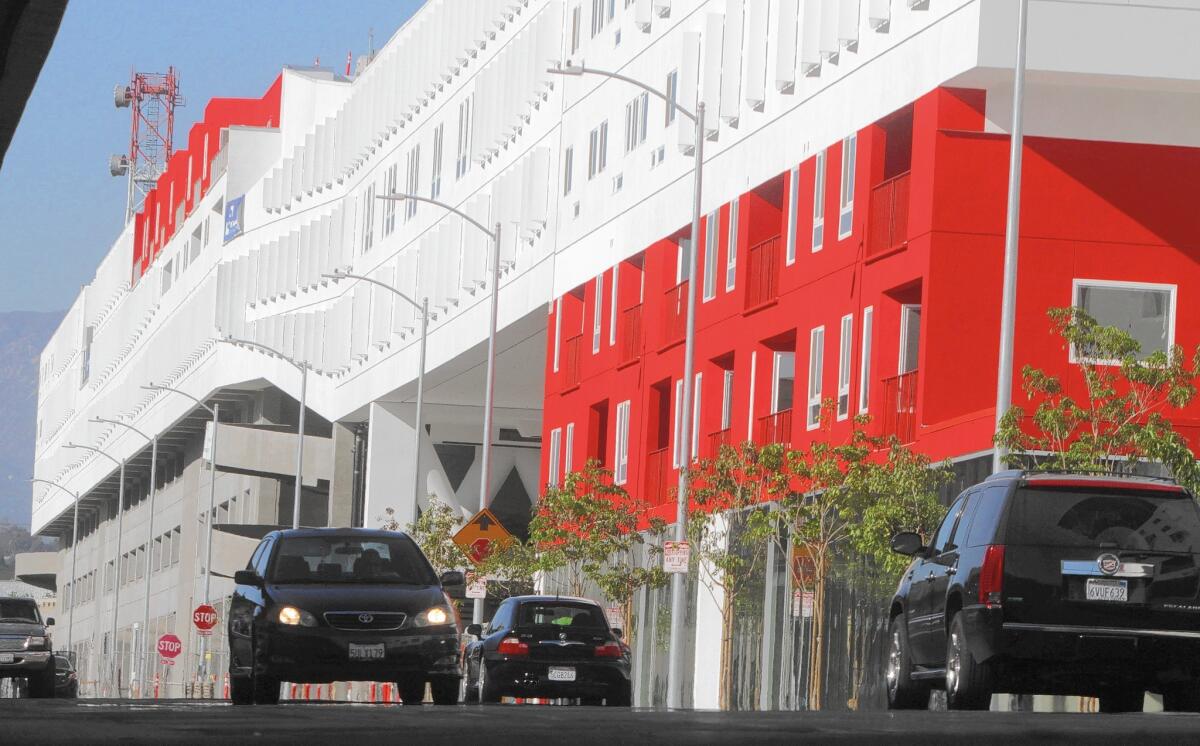Upscale new residential complex opens in L.A. arts district

- Share via
In what may be the strongest sign of the neighborhood’s upscale transformation, a massive residential project — which looks more like a long train than a typical apartment complex — has opened in the arts district of downtown Los Angeles.
The 438-unit One Santa Fe development — nicknamed the “Empire State Building on its side” — has begun welcoming its first residents. If stacked vertically, the more than 1,500-foot-long project would rise higher than the New York landmark.
“Twenty years ago, I don’t think anyone would have imagined this,” said John Zanetos, a real estate broker with CBRE’s downtown office.
In the last decade, the neighborhood has transformed from a sparsely populated industrial district into one flush with trendy coffee shops, bars and restaurants. Warehouses have been converted to condos and lofts.
The neighborhood continues to boom with development. An arts center, backed by an international gallery powerhouse, is moving into a former flour mill complex on 3rd Street. Just down the road, Lowe Enterprises is constructing a 320-unit apartment complex with 15,000 square feet of retail space.
In size and design, however, One Santa Fe stands out.
Designed by well-known architect Michael Maltzan, the white, two-building complex is nestled between the Southern California Institute of Architecture and a rail yard that abuts the Los Angeles River. The first 124 apartments are now open, with the rest scheduled to be ready before year’s end. Many residents are expected to come from SCI-Arc and other nearby schools.
They’ll find a private yoga studio, saltwater pool, fitness center and outdoor theater. Rents for the studios, one bedrooms and two bedrooms range from $1,680 a month to more than $4,000.
“The arts district is maturing and it’s becoming an increasingly desirable place to be,” said Bill McGregor of McGregor Brown Co., one of the developers on the project.
Next year, a collection of shops, restaurants and community art spaces is set to open on the project’s ground floor. Tenants include a family-owned grocery store, a gourmet vegan restaurant and an artisanal ice cream shop. McGregor expects the shops, and hundreds of new residents, to transform Santa Fe Avenue from what was once a dead industrial street into a lively, urban boulevard.
The $160-million project is a sign of just how much the area has changed, said broker Paul Darrow of Marcus & Millichap. Until now, most development has been conversions of old industrial spaces. But as rents have risen, brand new projects have started to make sense financially, Darrow said.
“We have big names and high-profile guys from ... coast to coast aware of the arts district,” he said.
In the past, few developers would have even considered the neighborhood for investment. Addicts shot up in the alleys. Artists leased empty warehouse space for dirt cheap. Many lived there illegally, until the city passed an artist-in-residence ordinance in the early 1980s. Locals flocked to Al’s Bar, a neighborhood institution, to hear bands such as the Misfits and Nirvana.
“There was a lively anarchist movement,” said Timothy Keating, president of Los Angeles Downtown Arts District Space, a nonprofit focused on promoting arts in the neighborhood.
Al’s closed in 2001 and the pace of change has accelerated. There are fewer artists now — a result of soaring rents, Keating said. The change has sparked concerns that the arts district could lose its artists, and in turn its character.
The urban character, and what Reed Alvarado called a sense of community, enticed the aspiring actor from Hollywood. He moved into One Santa Fe in late August. Soon after, the former barista said, he bumped into a district resident he used to serve at a nearby coffee shop. He mentioned his new apartment.
“People are already starting to move in there?” the woman replied, a bit alarmed, according to Alvarado.
Questions continued: Is there parking? What type of shops are coming?
“It was an interrogation for sure,” he said.
McGregor said One Santa Fe is a good fit for the neighborhood. A lease with the Metropolitan Transportation Authority, for part of the ground-level commercial space, allows for more offbeat retailers instead of the stable, national chains that dominate most new developments, he said.
There are 88 apartments for lower-income households, and Keating’s nonprofit has a donated retail space. A gallery and 99-seat theater are planned for the Arts District Center for the Arts at One Santa Fe.
“A petri dish for the arts,” Keating said.
Architect Maltzan said he tried to create a project for the arts district of today, but also the future. He left an open space in the middle of the project — one he said would allow the public to one day walk through One Santa Fe to a possible subway station or a revitalized L.A. River.
Maltzan said he was trying to make sure the architecture “didn’t just speak to our situation in the city right now, but hopefully anticipate the way the city will continue to evolve.”
Twitter: @khouriandrew
More to Read
Sign up for Essential California
The most important California stories and recommendations in your inbox every morning.
You may occasionally receive promotional content from the Los Angeles Times.







